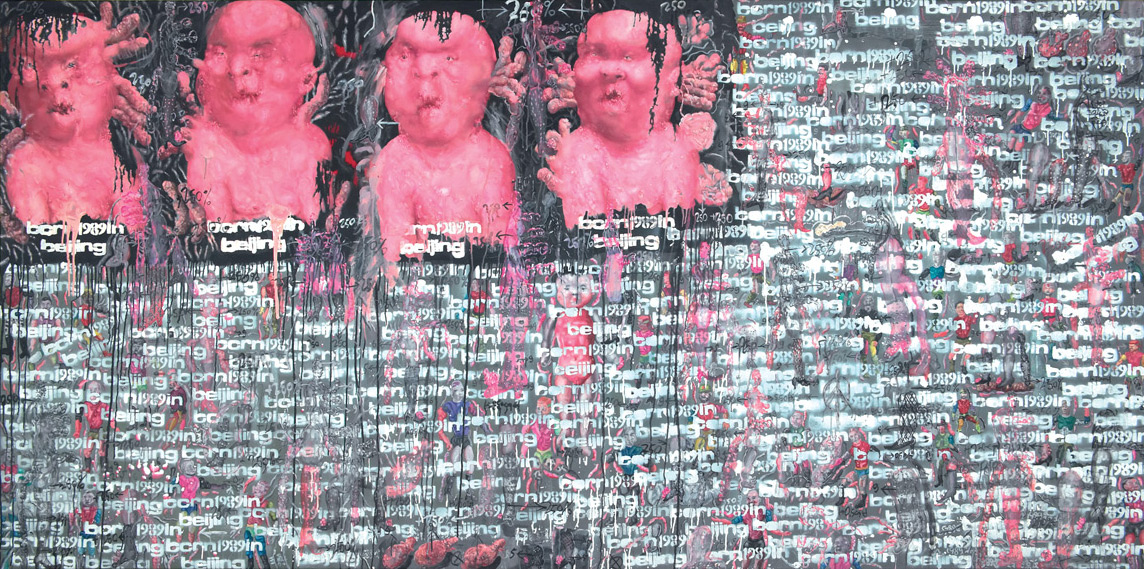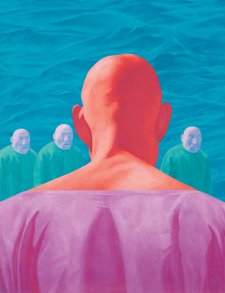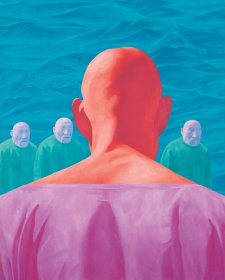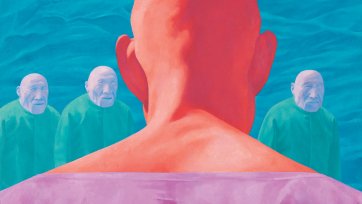“Since the early 1990s Liu has worked in oil. His satirical paintings of the revolutionary family, members of his own family depicted with images of Mao Zedong, gave rise to the term ‘Cynical Realism.”
(Roberts C. , Go Figure! Contemporary Chinese Portraiture, 2012)
Context and comment
“In the absence of a full official acknowledgement of what occurred in Tiananmen Square on June 4 1989, artists have reflected privately on the trauma and responded in a variety of indirect ways. The art critic and curator Huang Zhuan refers to the ‘indescribability’ of that time. It was, he said ‘a composite crisis of reality composed of China’s culture, economy, politics, society, psychology, and belief’. Like Fang Lijun, Liu Wei (b. 1965) was trained in the print-making department of the Central Academy of Fine Arts and turned to painting. Born 1989 in Beijing (250%) dates from 1995/6 and displays Liu’s virtuosic painterly style. Vulnerable, flesh-pink babies with macabre growths emanating from their ears and shoulders as if they are about to explode are silhouetted against a sombre black ground, hemmed in by a wall of text. The words ‘Beijing’ and ‘1989’ are repeated in white letters across the large canvas as if to prevent forgetfulness about the significance of that watershed year.”
(Roberts C. , Go Figure! Contemporary Chinese Portraiture, 2012)
“The government crackdown on student movement in Tiananmen Square crushed the political aspiration of the young generation. The twin events dealt a double blow to the artists of the 1980s, bringing their high-minded idealism to a crushing ground and deflated their illusion that their aspiration was part of a collective dream of modernization.”
(Wang, Three decades: Themes, 2012)
Further reading
Individual and context
china.arts.ubc.ca
The Liu Wei I know
www.artzinechina.com
Liu Wei in his studio
www.artlinkart.com
Heinrich, C. (2005). Mahjong; Contemporary Chinese Art from the Sigg Collection. (B. F. Frehner, Ed.) Germany: Hatje Cantz .pp. 133
Andrews, J. F. (2008). Mahjong; Art Film and Change in China. (J. M. White, Ed.) Berkeley, California, USA: University of California, Berkely Art Museum and Film Archive. pp. 29 - 56
Roberts, C. (2012). Go figure! Contemporary Chinese Portraiture. (D. C. Roberts, Ed.) Canberra and Sydney, Australia: National Portrait Gallery and The Sherman Contemporary Art Foundation.















